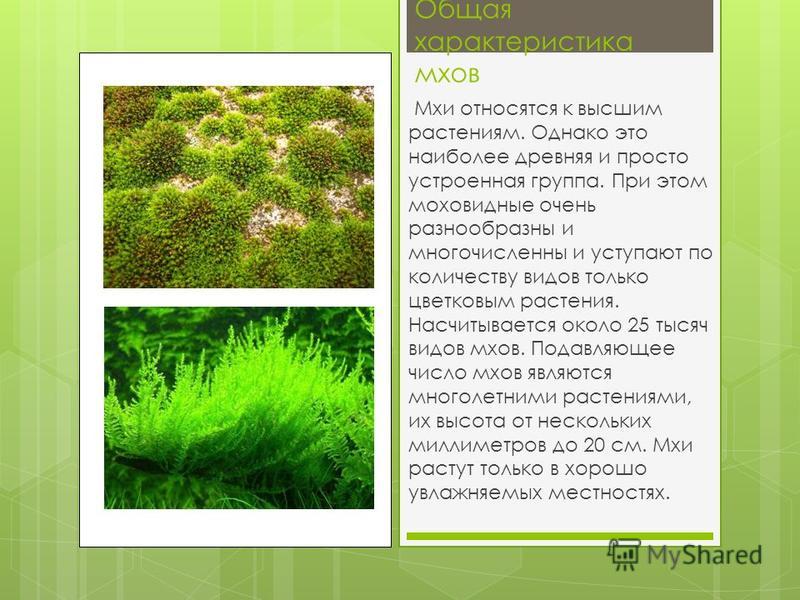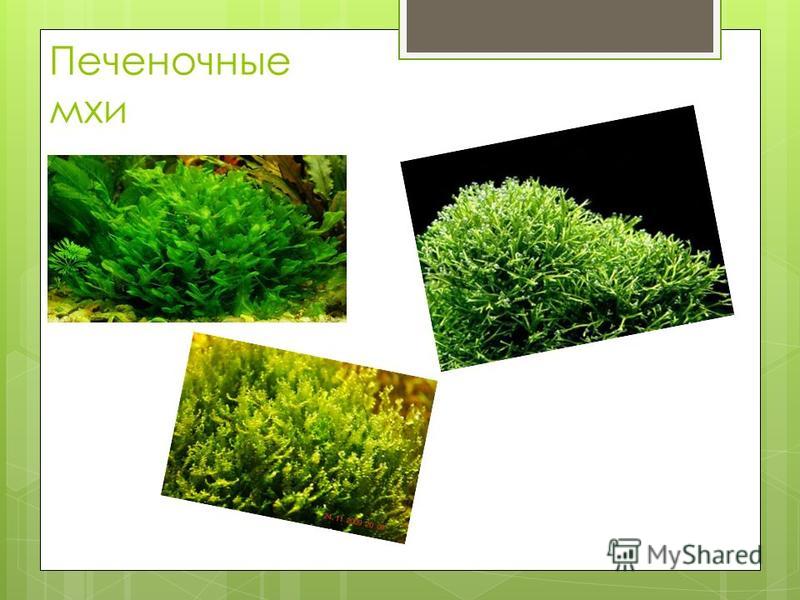Mosses General characteristics of mosses Mosses belong to higher plants. However, this is the most ancient and simplest organized group. At the same time, bryophytes are very diverse. - presentation
General characteristics of mosses Mosses belong to higher plants. However, this is the most ancient and simplest organized group. At the same time, bryophytes are very diverse and numerous and are inferior in the number of species only to flowering plants. There are about 25 thousand species of mosses. The overwhelming majority of mosses are perennial plants, their height is from a few millimeters to 20 cm. Mosses grow only in well-moisturized areas.


Liver mosses Liver mosses are small and tender bryophytes. Some of them (leafy hepatic mosses) have stems and leaves, devoid of any veins and arranged in two or three rows; those on the side facing the soil are scale-like and of a completely different shape than the others. The upper leaves, usually arranged in two rows, have two lobes, of which one small takes a special shape and is bent downwards. Others represent a flat or flatish thallus, spread out on the ground or even floating on the water. This thallus usually branches in a branchy, dark green color and bears, in some, on the underside, delicate scales arranged in two rows and corresponding, apparently, to the leaves.


Leafy mosses In leafy mosses, the body has shoots, which consists of stems and leaves. The gametophyte has a stem and leaves - usually single-layered, located on the plant in a spiral. Rhizoids are multicellular branched. Sphagnum (peat) mosses have large whitish-green, yellow, brown or reddish stems with leaves of alternating chlorophyll-bearing and air cells; predominate in the tundra, swamps and humid forests. Andrew's mosses have small red-brown stems with single-layered leaves; usually grow in pads on rocks high in the mountains. Shaved mosses differ from others in the mechanism of dispersing spores from the capsule (using special teeth), they usually grow in moist Kukushkin flax

![]()
Reproduction of mosses Mosses have asexual and sexual reproduction. Asexual is represented both by vegetative reproduction, when the plant reproduces by parts of the thallus, stems or leaves, and by spore reproduction. During sexual reproduction, mosses grow special organs in the upper body. They form the gametes of motile spermatozoa and immobile eggs. Sperm move through the water to the egg and fertilize it. After fertilization, a so-called spore box grows on the plant. After maturation, the spores scatter and are carried over long distances. The spore, once in a favorable environment, develops into a multicellular green thread, the protonema, on which thalli or shoots then grow.

Conclusion While developing intensively, mosses contribute to waterlogging of soils and worsen the quality of meadows. Peat mosses release humic acids that prevent decay, due to which the accumulations of dead moss are compressed into peat over time. Peat is mined as a mineral and used as fuel or fertilizer. In addition, some chemicals are obtained from it. Sphagnum mosses are used as bedding for livestock. Since sphagnum absorbs large amounts of water (30–40 times its body weight), it was used as a bandage during the war.









